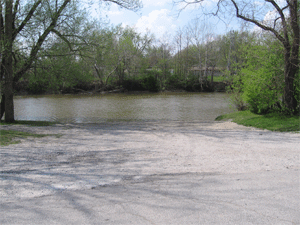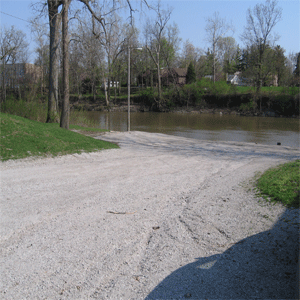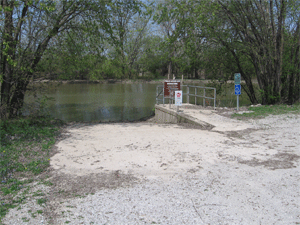River Levels
Fort Wayne's rivers are natural systems and, just like other rivers, the levels and depths fluctuate for a variety of reasons during many times of the year. City Utilities has a limited ability to affect river levels by adjusting two dams - one on the St. Joseph River near Johnny Appleseed Park and one on the Maumee River near Anthony Boulevard bridge.
Maumee River & Hosey Dam
City Utilities can lower river levels by a few feet by opening a gate at the Hosey Dam on the Maumee River and allowing more water to flow downstream. Opening this "tainter" gate is similar to opening a drain in a bathtub. However the difference is that opening the gate does not allow the rivers to empty completely. Even when the gate is open, only a limited amount of water can flow out of the river system. So it is possible to have river flooding even if the gate is open. The likelihood of flooding depends on the amount of rain received in the City and upstream on the St. Joseph and St. Mary's Rivers.
 Between October 15 and April 15, the tainter gate is left open and rivers fall to a low winter pool level. Between April 15 and October 15, the tainter gate is typically closed and the rivers rise to their normal summer pool level. Sometimes during the summer, the level of Fort Wayne's rivers may be lowered for planned construction or maintenance projects. Log jam removal, bridge or dam repairs, and sewer improvement projects are just some examples of work that might necessitate the lowering of river levels. The Tainter Gate Policy was established in 2007.
Between October 15 and April 15, the tainter gate is left open and rivers fall to a low winter pool level. Between April 15 and October 15, the tainter gate is typically closed and the rivers rise to their normal summer pool level. Sometimes during the summer, the level of Fort Wayne's rivers may be lowered for planned construction or maintenance projects. Log jam removal, bridge or dam repairs, and sewer improvement projects are just some examples of work that might necessitate the lowering of river levels. The Tainter Gate Policy was established in 2007.
St. Mary's River
The United States Geological Survey (USGS) operates several river level gauges around Fort Wayne. The gauge located on the St. Mary's River at the Main Street bridge most clearly shows the impact of opening or closing of the tainter gate. Real time data showing the depth of the St. Mary's River at the Main Street Bridge is available from the USGS. If it has not bee raining, looking at the USGS data before and after the tainter gate is adjusted can give you an idea of how changing the gate affects river levels in Fort Wayne. The USGS can provide you with instant, customized updates of water conditions through their Water Alert Program.
St. Joseph River
In the spring, the level of the St. Joseph River north of the dam at Coliseum and North Anthony Boulevard is raised. This is done by inserting extensions called "flashboards" that raise the level of the dam so that more water can pull upstream. This helps to ensure that the City has an adequate supply of raw water to use for making treated water during the dry summer months.
The flashboards are usually put in place in April and removed in October or November. In order to insert or remove the flashboards, the river level on the St. Joseph River upstream of the dam must be temporarily lowered so that work can be done safely. The water level is lowered by opening gates at the St. Joseph River Dam and allowing water to fall to a lower level upstream of the dam. After the boards are installed, the gates are closed and river levels return to normal. It typically takes one to two days to adjust river levels.
Special Events Affected by Water Levels
If you are planning an event that requries rivers in the downtown area to be at a particular level - either high or low- please email City Utilities at This email address is being protected from spambots. You need JavaScript enabled to view it.. We will make every effort to accommodate requests if possible. However, please understand that the ability to control river levels with dams is limited and that flooding is beyond our ability to control. Requests for river level adjustments must be received at least 30-days in advance of the event.






 Between October 15 and April 15, the tainter gate is left open and rivers fall to a low winter pool level. Between April 15 and October 15, the tainter gate is typically closed and the rivers rise to their normal summer pool level. Sometimes during the summer, the level of Fort Wayne's rivers may be lowered for planned construction or maintenance projects. Log jam removal, bridge or dam repairs, and sewer improvement projects are just some examples of work that might necessitate the lowering of river levels. The
Between October 15 and April 15, the tainter gate is left open and rivers fall to a low winter pool level. Between April 15 and October 15, the tainter gate is typically closed and the rivers rise to their normal summer pool level. Sometimes during the summer, the level of Fort Wayne's rivers may be lowered for planned construction or maintenance projects. Log jam removal, bridge or dam repairs, and sewer improvement projects are just some examples of work that might necessitate the lowering of river levels. The 
